Cleaning soot from stove and fireplace chimneys: the best means and methods for getting rid of soot in a chimney
Regular cleaning of soot from chimneys of stoves and fireplaces is a mandatory procedure, regardless of the frequency of use of the heating device. Modern chemical preparations, time-tested folk remedies and special mechanical methods are suitable for these activities.
The choice of the most effective method depends on the level of contamination of the chimney ducts and the desire of homeowners to do everything themselves or, in the full sense of the word, without getting their hands dirty, to entrust the work to professionals.
Are you planning to get rid of the burning yourself, but don’t know which method to use? We will help you decide on your tactics. The article provides a detailed overview of the most effective methods, indicates the reasons for the rapid clogging of the chimney and indicates the timing of cleaning activities.
The content of the article:
Why does the chimney become clogged?
Clogging of chimney ducts is a natural process that occurs as a result of combustion. Only part of the fuel, breaking down into fractions, acquires a gaseous form and is released into the atmosphere as an emission.
Other fragments with a heavier, dense structure take the form of soot deposits and settle on the inner surface of the pipeline, over time significantly worsening its throughput.
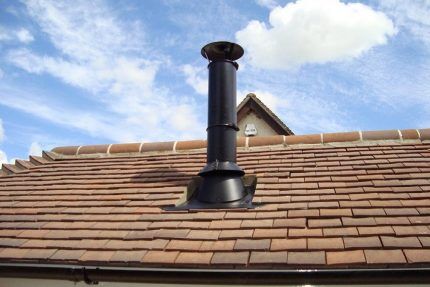
The use of firewood from coniferous trees causes clogging of channels. Viscous resinous substances, contained in excess in the composition, form a powerful adhesive base and help retain soot deposits on it.
Such contamination is difficult to clean with preparations and requires careful removal using mechanical devices.
Household waste, packaging containers, remains of old furniture, textiles and other items that are not a fuel resource by definition, during combustion, emit caustic ether complexes, heavy carcinogens and resinous compounds.
Therefore, burning such human waste in the furnace of a stove or fireplace negatively affects the operation of heating equipment of any class.
All of them, in the form of a dense, viscous sediment, cover the inner surface of the pipes and create conditions for retaining soot, carbon deposits and soot. The channel through which gaseous elements escape into the atmosphere narrows to a minimum, the draft overturns, and part of the smoke enters the living room.
The temperature in the room drops, and the use of heating equipment becomes dangerous due to the risk of carbon monoxide poisoning.
They accelerate the clogging of the chimney channel with deposits of firewood from recently cut, damp forest.
If the current humidity of a log exceeds 12%, throwing it into the firebox immediately is strictly prohibited. It must be thoroughly dried in a warm room for at least 1 week.
Damp logs reduce the level of heat transfer by 35%, quickly clog the smoke exhaust system, and eventually cause it to fail.
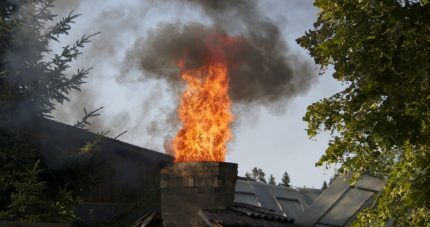
Sometimes the active accumulation of soot inside the pipe is provoked by mistakes made accidentally or due to inexperience during the process of laying the firebox and arrangement of a chimney for a fireplace or oven.
It could be:
- incorrectly calculated pipe angle;
- the walls of the drainage system are too thin;
- incorrectly selected chimney pipe;
- increased volume of condensate formed due to insufficient thermal insulation;
- excessive number of bends and turns of the chimney;
- roughness on the inner surface of the outlet channels.
It is these reasons that accelerate the contamination of chimneys and reduce the efficiency of stoves, boilers and fireplaces several times. Homeowners are advised to be very careful when choosing stove makers and to contact only those who have already proven their skills and high qualifications.
Otherwise, the question of how to clean your home chimney will arise with enviable regularity, causing you a lot of trouble and requiring constant financial costs.
Symptoms of a blocked chimney
It is not difficult to guess that the chimney system is clogged. This is clearly indicated by the sharply decreased draft in the firebox and a noticeable cooling in the rooms.
Problematic primary ignition of the fuel resource and random flame extinction also indicate a decrease in the permeability of the channels and a violation of proper air exchange.
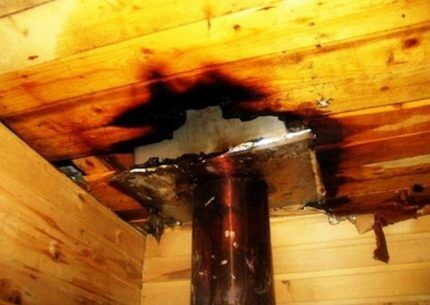
A signal that the chimney needs cleaning is a change in the color of the flame in the combustion chamber. A fire that turns a juicy orange color as it burns clearly implies a problem.
This is also evidenced by the unexpected smell that appears, which is uncharacteristic of the normal operation of the firebox.
Cleaning Frequency
For preventive purposes, experts strongly recommend inspecting and visually inspecting stoves, solid fuel boilers, fireplaces and chimney ducts.
Schedule of planned audits:
- any heating equipment – after initial installation in a residential area, immediately before launch, after completion of repair work;
- seasonal operation systems – before the start and at the end of intensive use;
- gas boilers and furnaces – twice a year in the first 2 years after installation/laying, then once annually;
- brick chimneys – quarterly;
- chimneys made of any other materials – every 12 months;
- outlet pipes of heating and heating-cooking furnaces – three times per season.
If problems are identified during the inspection, they must be corrected immediately. Then the system will function correctly and provide the proper level of comfort and fire safety in residential premises.

You can organize cleaning activities yourself or use the services of a chimney sweep. The main thing is to correct all problems in a timely manner and ensure that the equipment can operate in normal mode.
TOP 5 chemicals for cleaning
Chemical products for routine cleaning of chimneys of solid fuel boilers, stoves and fireplaces are attractive due to their simplicity, reasonable cost and ease of use.
Owners do not have to purchase special equipment, get their hands dirty with soot, and make serious physical efforts to return the equipment to working order.
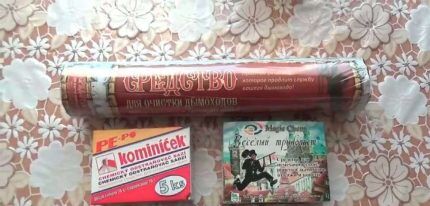
Purchased preparations are simply poured into the fire in a certain volume or placed together with firewood when kindling. During thermal exposure, the working components react with soot or resinous elements and contribute to their decomposition.
The gaseous part, along with the smoke, escapes into the atmosphere, and the dry part simply falls to the bottom. Then it is removed along with solid combustion products and ash.
Many domestic and European companies are engaged in the production of chemical reagents for cleaning. Their products are in stable demand and cope well with their tasks.
Product #1 – Sadpal Cleaning Powder
Polish remedy Sandpal is a non-explosive and non-flammable fine-grained green powder.
It consists of a complex of inorganic salts and serves as a catalyst for the afterburning of soot that has settled in the chimney part of fireplaces and stoves. Effectively affects organic matter, decomposing it to water and carbon dioxide.
In a volume of 1 tablespoon, pour into a well-heated combustion chamber directly onto the smoldering parts of the fuel. If kindling is carried out with a dry resource, the dose is slightly reduced, and for a wet resource with a weak, insignificant combustion coefficient it increases by 10-15%.
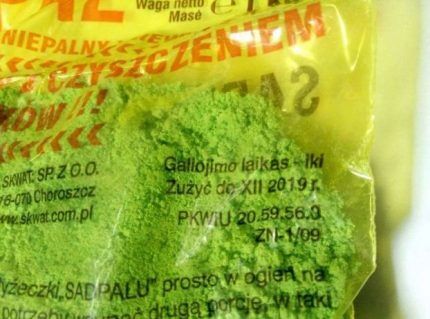
During the oxidation of soot, large fractions of the resulting substance fall to the bottom of the combustion chamber, and small fractions, together with the flue gases, rise upward and go into the outlet pipe.
Using Sadpal cleaning powder you can:
- optimize coal and firewood consumption;
- reduce the risk of ignition of residual soot deposits;
- reduce the volume of sulfur emissions into the atmosphere;
- protect metal fragments located in the chimney section from corrosion;
- protect ceramic elements of the system from cracking.
With regular maintenance, the pipe will no longer become clogged with combustion waste, will not suffer from resinous deposits, and will not require complex and labor-intensive mechanical cleaning.
Remedy #2 – Hansa concentrate
Concentrate Hansa manufactured using German proprietary technology at the production facilities of a plant in Lithuania.
It is a fine-grained blue-white powder from a mixture of crystals, packaged in plastic jars with lids or economical high-strength plastic bags.
Individual components act as catalysts and stimulate the decomposition of wood resins into flammable gases. Other elements themselves, during the heating process, produce gas compounds that destroy the structure of soot, soot and tar deposits.
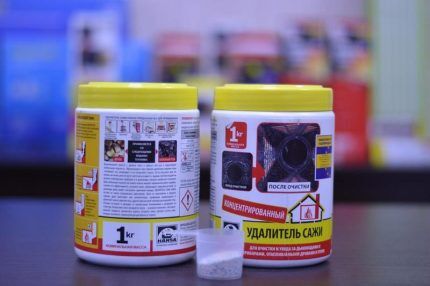
The adhesion to the surface of the chimney system weakens and all excess is released into the atmosphere along with other emissions. The product comes with detailed instructions telling you how to clean the home chimney of solid fuel stoves and boilers, open and closed fireplace systems.
In addition to powder, the company produces log "Chimney Sweep" and pellets for preventive maintenance of heating units operating on granular fuel.
Tool #3 - chemical composition Kominicek
A drug Kominichek manufactured in the Czech Republic. Designed to remove soot deposits and other combustion products from the chimney that are prone to spontaneous combustion and impair the traction properties of stoves, boilers and fireplaces.
During the heating process, it reacts with substances deposited on the inside of the pipes and decomposes them.
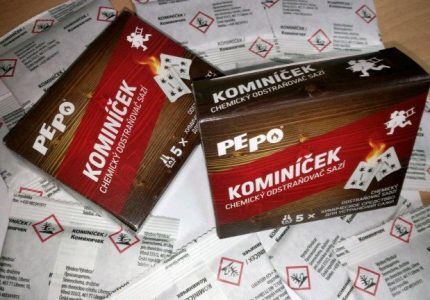
After servicing, stoves and fireplaces operate more efficiently, and fuel consumption is noticeably reduced. The possibility of spontaneous combustion of tar and soot deposits is reduced to zero. Using heating equipment again becomes safe, convenient and comfortable.
Remedy #4 – “Smoke” products from Ecolays
Domestic company Ecolays produces products for cleaning chimney pipes in three versions:
- granules;
- box;
- log.
The granular preparation is intended for pellet boilers and stoves. It is mixed with a medium-grained fuel composition and poured into the combustion chamber.
The boxed version consists of metal salts and activated carbon. The outer labels are removed from it, placed in the firebox, doused with a special liquid and set on fire. The product works for an hour and a half, transforms soot into a brittle substance and stimulates its rapid combustion.
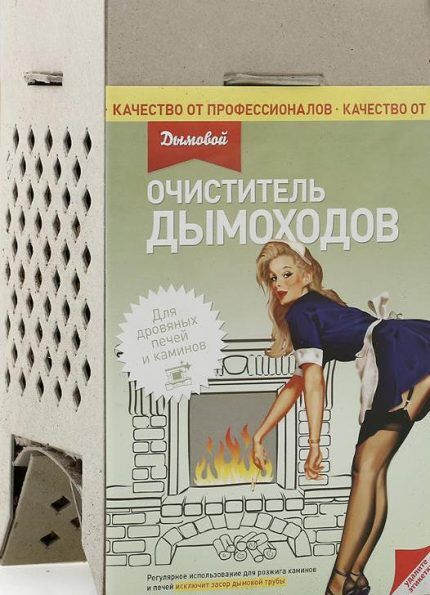
The Smoke log is shaped like a neat block of natural wood. It is placed in the firebox along with a load of firewood and does not reveal its presence there in any way.
During the heating process, it produces a specific azure-colored flame. This means that the components have already reacted with deposits and cleaning is proceeding normally.
Remedy #5 – Spalsadz cleansing powder
Polish catalyst for burning tar and soot deposits Spalsadz Available in powder form. Contains inorganic salts.As the temperature rises, it releases components that decompose organic structures into water and carbon dioxide.
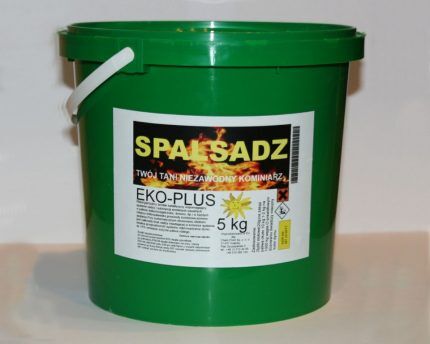
The drug does not react with ceramic fragments of the smoke exhaust system. After global cleaning, the efficiency of heating devices increases by 20%.
The use of folk remedies
Opponents of chemicals and modern methods prefer to clean smoke systems using the good old folk methods. They are simpler, more accessible and recognized as the safest.
Natural components work slowly and delicately, but do not cause any damage and do not have a negative impact on the system and its constituent elements.
Method #1 - cleaning with rock salt
Rock salt is one of the most accessible, cheap and environmentally friendly reagents for removing soot from chimneys. There is no need to prepare specially for cleaning. Simply pour a few large handfuls onto the wood and light the fire right away.
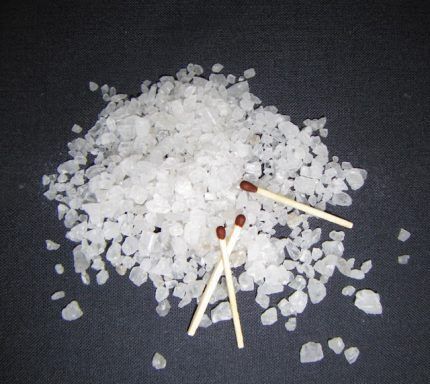
During fuel combustion, a lot of oxygen is released. It softens the soot on the inner surface of the pipe and reduces its layer.
Part of the soot flies into the atmosphere in the form of gas, and the remainder falls into the kindling part in the form of a dark powder. Then you can simply scoop it out with a metal scoop or remove it with a powerful vacuum cleaner.
Method #2 - Potato peels for pipes
Potato peeling (peeling) is an easy way to rid the chimney of soot and soot. True, to achieve a noticeable effect, you will have to prepare a lot of cleanings - depending on the size of the stove or fireplace, from half to a whole bucket.
They will first need to be dried to a brittle state and only then loaded into a well-heated firebox.
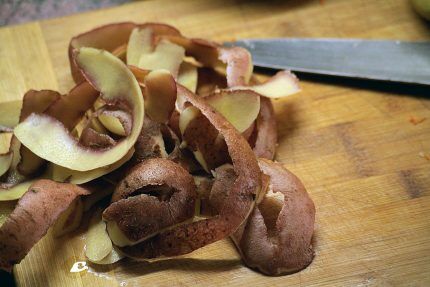
During the catalysis process, the bitumen components will gradually burn out, and the result will resemble the effects of chemical reagents, only in a milder version.
Soot powder will continue to pour into the combustion part for a few more days, and then this will stop, and the overall level of system efficiency will improve. Periodic burning of potato peelings is an excellent prevention of the occurrence of reverse draft in the chimney.
Method #3 - aspen firewood to remove soot
Firing a stove or fireplace with aspen wood is a simple and quite effective cleaning procedure. Its convenience lies in the fact that no additional actions need to be performed. All you need to do is place the wood in the firebox, light the fire and wait for it to burn completely.
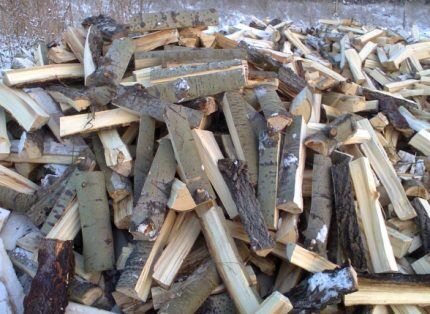
As a resource for constant heat generation, aspen firewood is not advisable. They burn too quickly and, compared to other types of wood, provide extremely poor heat transfer.
But, as a cleaning element, they are effective and popular. During the heating process, the chimney becomes very hot and is naturally cleared of build-up and deposits.
Features of mechanical cleaning
Mechanical cleaning of chimney channels is another effective method of removing accumulated soot, soot and tar deposits that reduce the quality of the heating system.
This is done in two ways:
- top;
- lower
Cleaning from above through the roof is carried out only in normal weather conditions and without wind. Requires experience, physical training and compliance with personal safety measures.
The master does all the work while standing on the roof of a residential building. With this option, dirt does not enter the living quarters, but is removed outside using special devices.
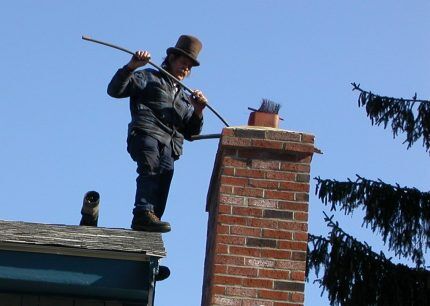
Bottom cleaning is carried out through the outlet of the firebox. The operation is safe and does not require being on the roof, but after it a lot of dirt and combustion residues remain in the rooms.
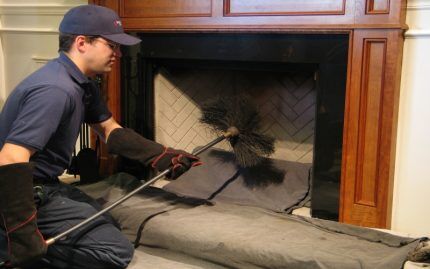
The main machining tool is a wide brush for round pipes or a stiff brush for square ones.
The work is labor-intensive and requires a certain skill. Many owners prefer not to do it themselves, but entrust it to a professional chimney sweep.
Additional information on cleaning the smoke duct yourself is presented in this article.
Conclusions and useful video on the topic
An interesting way to clean pipes that does not require climbing onto the roof - simple, modern and effective.
What to do if the stove or fireplace begins to smoke and the traction properties have noticeably weakened. How to clean drainage channels with your own hands.
Test of three popular chimney cleaning chemicals. Real results and comparison of the effectiveness of drugs from different manufacturers.
Regular cleaning of chimney pipes and channels is a very necessary and useful procedure. It has a beneficial effect on the general condition of the heating system, restores the traction properties of the equipment and promotes economical resource consumption.
Preventive measures can be carried out independently as needed, strictly adhering to the instructions for the drugs and safety regulations. In case of blockages or other more serious problems, it is better to use the services of experienced specialists.
Do you have personal experience cleaning a stove or fireplace chimney? Please tell readers what soot removal method you used. Leave comments, ask questions and participate in discussions - the feedback form is located below.




I grew up in a private house in a village. We had stove heating, so I remember well all the “charm” of cleaning the chimney. Now my parents live there. They found a good, convenient and fast way to get rid of soot. In the village there lives a man who himself made a device similar to a fan. On the roof he lowers it into the chimney and the soot flies out with the air flow.I don’t know exactly how it works, but this procedure is enough for the season.
If you do everything wisely and regularly prevent the accumulation of soot, then no problems should arise with cleaning the stove chimneys. In general, initially it is worth doing without a large number of bends in the chimney, because it is in them that soot likes to accumulate. It is imperative to insulate the chimney so that the channel warms up quickly and the dew point is as high as possible. In this case, mechanical cleaning may not be useful at all.